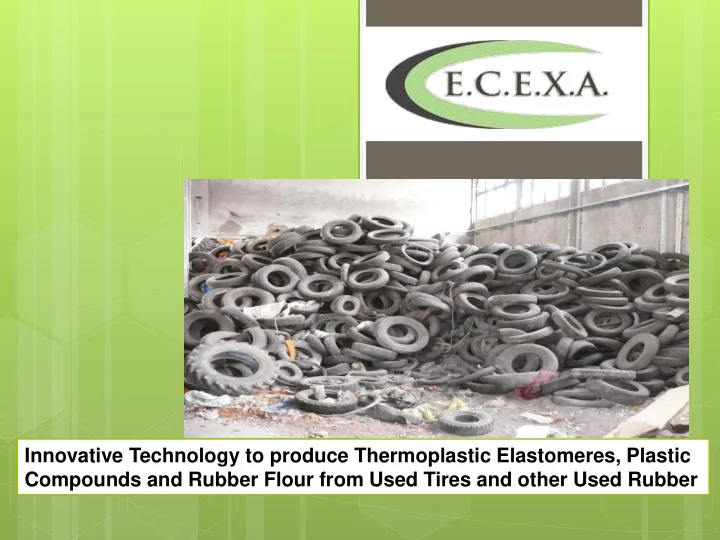

Innovative Technology to produce Thermoplastic Elastomeres, Plastic Compounds and Rubber Flour from Used Tires and other Used Rubber
As a manufacturer of turn key projects we have together with the German FRAUNHOFER INSTITUTE developed a completely innovative technology to produce Thermoplastic Elastomeres (TPE) and Plastic Compounds from used tires and other used rubber , whereby up to 70 % of rubber flour from used tires mixed with plastics and additives is compounded into TPE granules and becomes a new raw material.
The market for TPE and plastic compounds is supplied raw by material suppliers our so-called compounders who manufacture and supply the appropriate material mixture for the different production processes. Advantages of our Machinery and Technology 1st on the market to produce TPE and plastic compounds from used tires Complete new raw material with exceptional properties (worldwide increasing demand for TPE Differentiation to conventional tire recyclers No competitor with anywhere near performance in quality, price, processing and cost/performance knowhow, networking etc. Attractive target markets with high volumes and growing demand
Basic Figures for the erection of a TPE plant with an annual capacity of approx. 30,000 used tires/year: Investment approx. € 35,900,000 (without land, buildings, infrastructure): approx. € 36,000,000 Annual Turnover (at full capacity): approx. € 8,500,000 Annual Cash Flow (at full capacity): Required Size of Land approx. 12-15,000 m²
The Innovation: Thermoplastic Elastomere (TPE) and other Plastic Compounds from Used Tires Concept of the Technology The core of the technology is the development and manufacturing of plastics, plastic compounds and optionally, semi-finished fabricates and finished products using a pre-defined specially treated rubber flour from used tires and other technical rubbers. Critical Assessment of Conventional Technologies The goal of granulation and grinding of used tires is to obtain a rubber particle as small as possible (100 to 500 micrometers) with a highly rugged surface free from metal and textile residues.
The Innovative Technology – Cryogenic Grinding Our new technology by means of cryogenic granulating and fine grinding eliminates the above mentioned disadvantages: Liquid nitrogen with a boiling temperature of -196 ° C is sprayed onto the material. Advantages over Conventional Technologies The first cryogenic level (step 1) already achieves a very good separation of rubber granules, steel, and textile as well as an optimal purity of the rubber granule The fine grinding (step 2) enables the production of small grain sizes which in conventional plants is a core problem The achieved cubic form of the rubber grain contrary to its fibre structure with conventional grinding leads to better cohesiveness in the finished product
The TPE Market Supply Chain – The Players in the TPE Market The final users are e.g. car industry suppliers, machinery and plant engineering, construction industry, electrical engineering and electronics, cable manufacturing, medical engineering, adhesive production, shoe industry, packaging and film production, furniture production, sports equipment, household goods, toys, etc. Market Development Currently, the market for TPE materials is characterized by two-digit growth rates annually. By 2013 the annual demand for TPE will increase by 6 % per year to 4.2 million tons as it is estimated by the US-market research institute Freedonia, Cleveland, Ohio.
Competition So far no direct competitors with our innovative technology could be ascertained. Contrary to TPE produced from oil-based materials being dependent upon the increasing oil price and currency exchange fluctuations, our technology offers a huge competitive advantage since we can offer our produced TPE at a highly flexible price which is much lower than that our competition offers.
Business Concept Strategic Positioning Based on our innovative technology as described above, the buyer of our plant positions himself not as a recycler of used tires but as a manufacturer of TPE and plastic compounds. Products TPE und Plastic compounds of various types as key products due to high value-added and high market growth Target Customers Suppliers to the car industry (biggest group) Construction industry (2 nd biggest group) electrical engineering and electronics, cable manufacturing, medical engineering, adhesive production, shoe industry, packaging and film production, furniture production, sports equipment, household goods, toys, etc.
SWOT-Analysis Weaknesses Strengths Finished products only available in 1st on the market to produce TPE and black or dark colour plastic compounds from used tires Complex coordination of the Completely new raw material with supply chain (input – processing – exceptional properties supply) Differentiation to conventional tire recyclers etc. Opportunities Risks Worldwide growing demand for TPE Medium-term risk of bottle-neck with high growth rate in the supply of used tires in Distinct USP and distinction versus the case of unfavourable conventional TPE producers (from oil- production site based TPE) Risk of revenue crisis if the No competitor with similar performance single value-added steps input, (quality, price, knowhow in production manufacturing, and sales are and the supply chain, etc.) not occupied with professional Valuable strategic knowhow of the staff plant constructor
Calculation Examples TPE Principally, our TPEs and TPUs are designer plastics which are produced according to the customer’s request and the material requirement. The different recipes are based on 50 % rubber flour and 50 % plastic material. The plastic additive is either PP, PE, PVE, PU, or under certain circumstances a blend with PVC. In the case of finished products with lower material requirements the share of rubber flour can be increased up to 75 %. The cost price and hence, the selling price is always based on the price of the added plastic material. According to our calculations and the market conditions in Germany the production costs of very fine rubber flour amount to approx. € 250/metric ton. The following examples with the calculations for the different finished TPEs (with conservative sales prices) show the possibilities that can be achieved with our TPE technology:
Recommend
More recommend